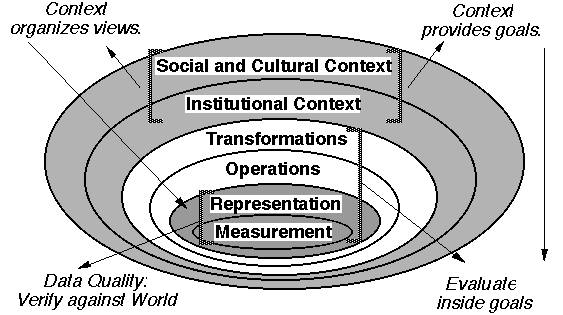What is this course about anyway?
Integration of information from different sources
Objectives
- Provide review of course material
- Refine learning objectives
- Present course in simplified form
Materials:
List of terms, Glossary
of book, Worksheet on Measurement frameworks,
Worksheets on measurement and reference systems (.doc),
Original form of Objectives,
The key trick of a GIS is integrating information
from diverse sources. The tough steps are when the integration
is not predetermined, but must be discovered from information
usually taken for granted.
In labs, we have used a raster solution in ArcMap Spatial Analyst:
Integration performed by imposing common set of spatial objects.
We have also used vector methods, integration by finding a common
geometry.

Review rings of ever increasing complexity (scope) provided at
start of course:
Integrate different Levels of Measurement
"Everything is a number" fallacy
How to balance a need to choose with diverse characteristics that
do not support the simple arithmetic of continuous measures. (weighting
and rating)
Learning to live with categories and what you can do with them.
Basic set theory expanded to handle less rigid rules
Nuances beyond Stevens: for example,
totals are different from classical ratio measures
Choice of control: Space controlled/ attribute measured NOT
EQUIVALENT TO attribute controlled/ space measured
Grid coding rules are a form of control: point vs. area; space
vs attribute
Thinking through to the axioms (assumptions) behind the measurements
Integrate by connecting transformed distributions
Geometric conversions - Buffers as
geometric constructions; other neighborhoods
Transform between frameworks: attribute
assumptions; neighborhood construction
Integrate different attitudes towards error (risk)
tradeoff between spatial and attribute resolution/ accuracy
SCALE (and all the decisions subsumed therein)
Integrate different spatial reference frameworks
actually raster forces this to be done externally, but it still
occurs.
Integrate different institutional arrangements
Making organizations with distinct goals cooperate; share a more
complex world view
Integrate different cultural frameworks
Making societies (cultures) with distinct goals cooperate;
share a common language
LESSONS:
Mathematics can help. Theoretical framework for measurement can
develop an outer bounds on what seem to be difficult problems.
Mathematics are not enough. Integration of information involves
meaning. Models are not universal, but must be rooted in the substantive
problem.
Index from Here: | Back to First
Lecture | List of key concepts
| Schedule of Lectures | Labs and Due Dates | How
to reach us
Version of 19 November 2003